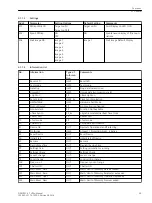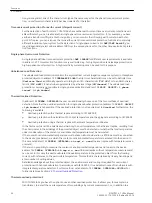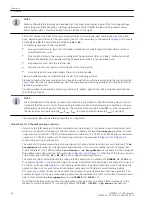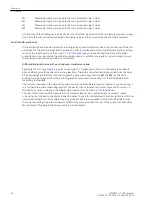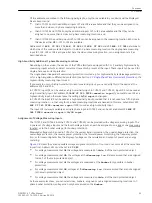
uring locations. It will be decided at a later stage which measured quantities should be used by which protec-
tion functions (section
).
Distinction must be made between the main protected object and other protected objects. The main protected
object is that to which the main protection function, i.e. the differential protection, is applied. This is the
power transformer, generator, motor, etc. as stated under address 105
PROT. OBJECT
.
The main protected object has 2 or more sides. The sides of a power transformer are the winding terminals, a
generator or motor is terminated by the terminal side and the starpoint side. In case of combined objects like
generators and transformers in unit connection the sides are the exterior terminals. The expression “side” is
applied exclusively to the main protected object.
The currents flowing into the protected object are taken from the measuring locations. These are represented
by the current transformers which limit the protected zone. They may be or may not be identical with the
sides. Differences between measurement locations and sides arise, for example, if a power transformer
winding (= 1 side) is fed from 2 galvanically connected lead wires via 2 sets of current transformers (meas-
uring locations).
The measuring locations which feed a side of the main protected object are the assigned measuring locations.
If the device provides more 3-phase current measuring inputs than are needed for the allocation to the sides
of the main protected object, the remaining measuring points are called non-assigned measuring locations.
These can be used for other protection, supervision, and measuring purposes which process 3-phase currents,
e.g. restricted earth fault protection, time overcurrent protection, unbalanced load protection, overload
protection, or simply for display of measured values. The non-assigned measuring points thus detect currents
of a further protected object.
Depending on the device version, one to four single-phase auxiliary current inputs for auxiliary transformers.
These can be used for processing of 1-phase currents, e.g. the earth current between a winding starpoint and
earth, or the leakage current between a transformer tank and earth. They can also be assigned to the main
protected object or can be non-assigned. If they are assigned to a side of the main protected object, they can
be processed by the differential protection (example: inclusion of the starpoint current in the differential
current). The currents of the non-assigned auxiliary inputs can be processed by other protection functions
(example: detection of a tank leakage current by the single-phase overcurrent protection, or they can also be
combined with other non-assigned 3-phase measuring points (example: restricted earth fault protection on a
protected object other than the main protected object).
illustrates the terminology by an example. Note that the example is not practicable in this arrange-
ment as it contains more connections than possible; it serves only for clarification of the terminology.
The main protected object is a two-winding transformer YNd with an earthed starpoint at the Y-side. Side
S1
is
the upper voltage side (Y), side
S2
is the lower voltage side (d). This definition of the sides for the main
protected object (and only for it) is the basis for the formation of the differential and restraint currents used in
the differential protection.
For the side
S1
2 measuring locations
M1
and
M2
exist. The currents that are measured there belong to the
side
S1
, their sum flowing on side 1 in the protected zone of the main protected object. The position of the
busbar isolator is not important here. Likewise, the polarity of the currents is not yet considered under
topology aspects.
At the lower voltage side, side
S2
also has two measuring locations because of its branch point to the auxilia-
ries system circuit:
M3
and
M4
. The sum of these currents flows into the low voltage side (
S2
) of the main
protected object.
The 4 measuring locations
M1
to
M4
are assigned to the sides of the main protected object, thus assigned
measuring locations. They are the basis for the measured value processing of three-phase currents for the
differential protection. Basically, the same applies to a single-phase transformer; Here, only the measured
currents of the measuring locations are connected in two-phase.
Measuring location
M5
is not assigned to the main protected object, but to the cable feeder, which is not
related in any way to the transformer.
M5
is thus a non-assigned measuring location. The currents of this
measuring location can be used for other protection functions, e.g. for 3-phase overcurrent protection for
protection of the cable feeder.
In 3-phase busbar protection there is no difference between measuring locations and sides; both correspond
with the feeders of the busbar.
Functions
2.1 General
SIPROTEC 4, 7UT6x, Manual
41
C53000-G1176-C230-5, Edition 09.2016
Summary of Contents for SIPROTEC 4 7UT6 Series
Page 394: ...394 SIPROTEC 4 7UT6x Manual C53000 G1176 C230 5 Edition 09 2016 ...
Page 482: ...482 SIPROTEC 4 7UT6x Manual C53000 G1176 C230 5 Edition 09 2016 ...
Page 504: ...504 SIPROTEC 4 7UT6x Manual C53000 G1176 C230 5 Edition 09 2016 ...
Page 522: ...522 SIPROTEC 4 7UT6x Manual C53000 G1176 C230 5 Edition 09 2016 ...
Page 528: ...528 SIPROTEC 4 7UT6x Manual C53000 G1176 C230 5 Edition 09 2016 ...
Page 538: ...538 SIPROTEC 4 7UT6x Manual C53000 G1176 C230 5 Edition 09 2016 ...
Page 664: ...664 SIPROTEC 4 7UT6x Manual C53000 G1176 C230 5 Edition 09 2016 ...
Page 666: ...666 SIPROTEC 4 7UT6x Manual C53000 G1176 C230 5 Edition 09 2016 ...
Page 684: ...684 SIPROTEC 4 7UT6x Manual C53000 G1176 C230 5 Edition 09 2016 ...



